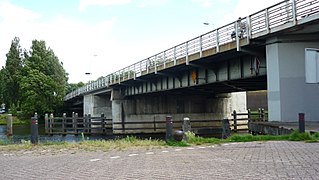
The Zuid-Willemsvaart is a canal in the south of the Netherlands and the east of Belgium.

The Gender is a stream in the Dutch province of North Brabant. It originates in originally marshy flatlands near Steensel and flows through Veldhoven and its eastern district Meerveldhoven in a general east-northeast direction towards Eindhoven.

The Dommel is a small river in Belgium and the Netherlands, left tributary of the Dieze. It is 120 km long, of which 85 km are in the Netherlands. The Dommel takes in water from the Keersop, Tongelreep, Run, Gender and Kleine Dommel streams and merges at 's-Hertogenbosch with the Aa stream to form the river Dieze, which subsequently flows towards the Meuse. The main cities and towns along the Dommel's course are Peer, Neerpelt, Valkenswaard, Dommelen, Eindhoven, Son en Breugel, Sint-Oedenrode, Boxtel, Sint-Michielsgestel and 's-Hertogenbosch.

The Aa is a small river in the Netherlands. It rises near Nederweert in the southeastern province of Limburg, in the Peel region. It flows northwest through the province of North Brabant towards 's-Hertogenbosch, roughly along the Zuid-Willemsvaart canal. In 's-Hertogenbosch, at the confluence of the Aa and the Dommel, the river Dieze is formed, which flows into the Meuse a few km further. The main cities and towns along the Aa's course are Asten, Helmond, Veghel and 's-Hertogenbosch.

The Dieze is a short river in North Brabant, the Netherlands, tributary of the Meuse. It is formed by the confluence of the rivers Aa and Dommel in 's-Hertogenbosch. The part of the Dieze in the centre of 's-Hertogenbosch is called Binnendieze, a partly covered network of canals. The Dieze flows into the Meuse near Hedel.

Binnendieze is the common name for the river and canal system within the city walls of 's-Hertogenbosch, the Netherlands. It is a tourist attraction. Near the north-west tip of the city walls, the confluence of the Binnendieze with the rivers Aa and Dommel forms the short river Dieze, tributary of the Meuse.
Brabants Dagblad is a daily Dutch newspaper. It is distributed in the center and northeast of North Brabant, in 's-Hertogenbosch and Tilburg and their surrounding regions. The paper's office is in 's-Hertogenbosch.

The Voorne Canal is a former ship canal on Voorne-Putten in South Holland, the Netherlands. It was the first canal to connect Rotterdam to the sea. Construction of the canal started in 1826 and was completed in 1829. Until the completion of the Nieuwe Waterweg in 1872 it was the main connection from Rotterdam to the sea for ocean going ships.

Fort Crèvecoeur was a Dutch fortress near 's-Hertogenbosch. It is now used as a military exercise terrain.

Meerwijk Castle is a Tudor Revival Style mansion on the east bank of the Dieze river just north of 's-Hertogenbosch. It was preceded by Meerwijk Manor, built on the same location.

Sluis 0 is a lock in the Zuid-Willemsvaart, in 's-Hertogenbosch, Netherlands. It is a large lock that will be made much smaller in the 2020s.

The City Gymnasium of 's-Hertogenbosch is a grammar school, which is known as a gymnasium in the Netherlands. It is the second oldest school of the Netherlands.

The Dieze Bridge is a bridge for road traffic, which spans the rivers Dieze and Aa, just north of 's-Hertogenbosch, Netherlands. The Dieze Railway bridge is somewhat further downstream.

The Lage Zwaluwe-'s-Hertogenbosch railway or Langstraatspoorlijn is a defunct and partially open railway line in North Brabant, Netherlands. It ran through Langstraat from Lage Zwaluwe railway station via Waalwijk to 's-Hertogenbosch railway station. Part of the line had been repurposed for recreation. It has the nickname Halvezolenlijntje. The Moerputten Bridge is a unique example of engineering.

Engelen Lock is a lock with vertical-lift bridge in the Dieze Canal near Engelen, North Brabant, just before the canal exits into the Meuse.

The Kleine Dommel or Rul is a brook in the Campine and Meierij van 's-Hertogenbosch, Netherlands.

The Wilhelmina Canal is a canal in North-Brabant, Netherlands. It connects Tilburg to the Meuse, and continues to the east to connect to the Zuid-Willemsvaart north of Helmond.

Wessem-Nederweert Canal is a canal connecting the Zuid-Willemsvaart at Nederweert to the Meuse near Wessem. Here it meets the wide Juliana Canal that connects to Maastricht.

Hedel Bridge is a tied-arch bridge over the Meuse dating from 1937 near Hedel, Gelderland. The bridge was built for the Oude Rijksweg, a former part of the A2 motorway that connected 's-Hertogenbosch to Utrecht.
PS Jan van Arkel II was a Dutch passengers paddle steamer of the Gorinchemsche Schiedamsche Stoomboot-maatschappij built by Fop Smit and launched on 8 March 1847. The ship was used for the 's-Hertogenbosch—Gorinchem—Schiedam line.




























